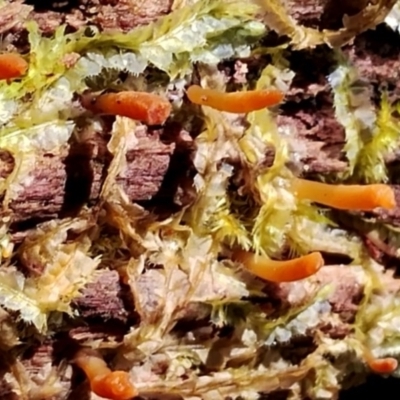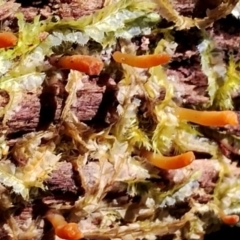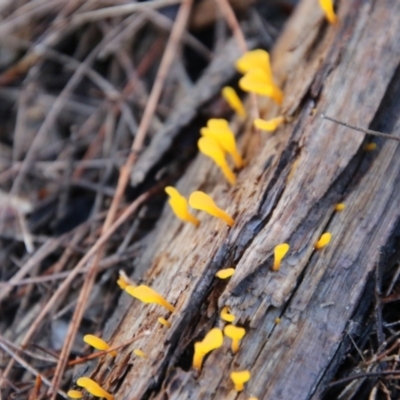Calocera sp. (A stagshorn fungus)
The fruit body is a stem, and often no more than that, but forking at the apex or slightly branched in some species. The fruit body has a fleshy to rubbery texture and is usually yellow to orange, though sometimes paler and close to buff. In most species the fruit bodies are no more than 3 centimetres tall (and often less than 1 centimetre) but those of Calocera viscosa may grow to over 10 centimetres and show more branching.
The fruit bodies appear on dead wood (of native or introduced trees) in a wide variety of habitats. Usually numerous fruit bodies appear simultaneously.
Identification of species usually relies on microscopic features.
Look-alikes
Some of the unbranched or slightly branched coral fungi (in the genera Clavaria, Clavulinopsis, Ramaria or Ramariopsis) have yellow fruit bodies and may be no more than a few centimetres tall. However, they grow mostly on soil, but a few species may appear on well-rotted wood. By contrast species of Calocera are found only on wood and usually on wood still far from rotted, albeit possibly covered by litter, mosses or the like so you may need to check carefully to be sure of the substrate.
Many Dacryopinax fruit bodies are yellow to orange, 1-2 centimetres tall and found on fairly firm wood. The fruit body consists of a short stem with a markedly broadened apex, from spatula-like to cup-like, sometimes lobed. Some species of Calocera may have slightly broadened apices and Dacryopinax is a genus that, on macroscopic features, could sometimes be confused with Calocera, especially when fruit bodies are immature. Since the fruit bodies of both genera usually appear in large groups, it may pay to look at the variation within the group, which is likely to include both immature and mature specimens, before making a decision.
Calocera sp. is listed in the following regions:
Canberra & Southern Tablelands | South Coast
Species information
- Calocera sp. Scientific name
- A stagshorn fungus Common name
- Not Sensitive
- Local native
- Non-invasive or negligible
- Up to 1335m Recorded at altitude
- Machine learning
Location information
-
Maps
ANBG Black Mountain Bluetts Block (402, 403, 12, 11) Bodalla State Forest Broulee Moruya Nature Observation Area Callum Brae Gibraltar Pines Kowen Escarpment Lake Ginninderra Lower Cotter Catchment Monga National Park Mongarlowe River Mount Majura Namadgi National Park Piney Ridge Tidbinbilla Nature Reserve -
Places
Kianga, NSW Uriarra Village, ACT






























































